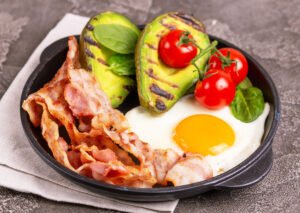
Best Low Carb Meal Ideas for Weight Loss

Obesity and weight-related health disorders are on the rise in today’s fast-paced world, where convenience foods and sedentary lifestyles have become the norm. Many people are continuously looking for effective strategies to lose weight and enhance their overall health. Adopting a low-carb diet is one popular method of losing weight.
Table of Contents
Introduction
Low-carb diets have grown in popularity due to their ability to help people lose weight and manage their blood sugar levels. These diets often limit carbohydrate intake, forcing the body to use fat for energy instead. In this comprehensive article, we will look at the details of low carb diets, their benefits, and a variety of low carb meal ideas for weight loss.

Understanding Low Carbohydrate Diets

Low carb diets have stood the test of time as a viable approach to weight loss and overall health improvement in a world where dietary trends come and go. These diets, often known as low carb diets, are based on the premise of carbohydrate restriction. In this comprehensive article, we will go deeper into the world of low carb diets, learning about their numerous forms, the science behind their methods, and the benefits they provide.
- What are Low Carbohydrate Diets?
Low carbohydrate diets, sometimes known as low-carb diets, are dietary programs that limit the consumption of carbohydrates. Carbohydrates are the body’s major source of energy and one of the three essential macronutrients. They can be found in a variety of foods, including cereals, fruits, vegetables, legumes, and sweets. The main goal of a low-carb diet is to minimize your carbohydrate intake, which will eventually lead to the body entering a state known as ketosis.
Ketosis is a physiological phenomenon that happens when the body is deprived of carbs. In this state, the body modifies its metabolism, shifting from predominantly using glucose (sugar) for energy to breaking down stored fat into chemicals known as ketones. During times of low glucose availability, ketones serve as an alternative energy source, notably for the brain and muscles. This shift in metabolic fuel lies at the heart of the success of low carb meals for weight loss and other health advantages.
- How Do Low Carbohydrate Diets Work?

The underlying idea of carbohydrate restriction underpins the operation of low carb diets. Individuals minimize the quantity of glucose flowing in their bloodstream by decreasing their carbohydrate intake. This, in turn, causes a cascade of physiological responses, culminating in the breakdown of fat for energy.
This is how low carb meal ideas for weight loss work:
Carbohydrate Restriction: Consuming fewer carbohydrates reduces your body’s major supply of glucose. As a result, less sugar is accessible for instant energy production.
Glycogen Depletion: As glucose availability decreases, the body begins to deplete glycogen stores. Glycogen is a kind of glucose that is stored in the liver and muscles. This glycogen depletion causes a decline in water weight, which is visible in the early phases of low-carb dieting.
Ketosis: As glycogen stores diminish, the body’s metabolic state switches to ketosis. The breakdown of fats, particularly triglycerides, causes the liver to produce ketones. Ketones, such as beta-hydroxybutyrate, acetoacetate, and acetone, have emerged as the primary fuel source for many tissues and organs, including the brain.
Appetite Suppression: Low-carb diets are frequently linked to decreased appetite and desires. Ketones have an appetite-suppressing impact, allowing people to better control their calorie intake.
Fat Burning: When the body relies on fat storage for energy, people lose weight because the body burns fat more efficiently.
Types of Low Carb Diets
Low carb diets come in many different varieties, each with its own set of principles and carbohydrate limits. Here are a few examples of well-known types of such diets:
- Ketogenic (Keto) Diet

The ketogenic diet, also known as keto, is the most well-known low carb diet. It is distinguished by a very low carbohydrate intake, which is normally limited to 20-50 grams per day, depending on individual circumstances. The induction of ketosis, in which the body becomes skilled at burning fat for fuel, is what sets the keto diet apart.
The keto diet emphasizes high fat consumption, which often accounts for 70-80% of daily caloric intake. This high fat consumption, combined with moderate protein consumption (20-25% of daily calories), generates a metabolic milieu that favors ketosis. The diet primarily limits carbohydrate-rich foods such as grains, sweets, starchy vegetables, and most fruits, while increasing the use of non-starchy vegetables, nuts, seeds, and healthy fats such as avocados and olive oil.
The keto diet has grown in popularity due to its ability to provide quick weight loss, improve blood sugar control, and improve mental clarity. It is used not only for weight loss, but also as a treatment for illnesses such as epilepsy and type 2 diabetes.
- The Atkins Diet

The Atkins Diet, created by Dr. Robert Atkins, is another well-known low-carb diet that has gone through various modifications over the years. It employs a staged strategy that consists of four stages:
Induction Phase: During the Induction Phase, carbohydrate intake is strictly restricted, with only 20-25 grams of net carbohydrates allowed per day. This phase is intended to kickstart ketosis.
Balancing Phase: During the Balancing Phase, people progressively increase their carbohydrate intake by eating more low-carb veggies, nuts, and seeds. The goal is to determine the “critical carbohydrate level for losing” (CCLL), or the maximum carbohydrate consumption that allows for weight reduction.
Pre-Maintenance Phase: During the Pre-Maintenance Phase, carbohydrate intake is increased further, allowing individuals to fine-tune their diet in preparation for long-term maintenance. At this point, individuals are concentrating on determining their appropriate carbohydrate consumption in order to maintain their weight.
Maintenance Phase: Individuals have discovered their carbohydrate tolerance level and can maintain their weight by keeping within this range during the Maintenance Phase.
With its stepwise approach, the Atkins Diet provides flexibility and personalization, making it more accessible to a wider spectrum of people. It focuses on protein and fat consumption and has been linked to weight loss, better blood sugar control, and improved cardiovascular risk factors.
- The Low-Carbohydrate, High-Fat (LCHF) Diet

The Low carb, High Fat (LCHF) diet is a low carb approach that focuses on carbohydrate restriction while increasing consumption of healthy fats. Unlike the keto and Atkins diets, which have strict carbohydrate limits, the LCHF diet does not have a daily carb limit. Instead, it encourages people to eat complete, unprocessed foods and to get the majority of their calories from fat sources like avocados, nuts, seeds, and olive oil.
This diet encourages people to prioritize quality over quantity, focusing on nutrient-dense foods while avoiding processed carbs and sugars. Although an LCHF diet may or may not cause ketosis, many people benefit from weight loss, improved insulin sensitivity, and general health advantages as a result of the reduced carb intake and emphasis on healthy fats.
- The Paleo Diet

The Paleo Diet, sometimes known as the “caveman diet,” is a low-carb diet that emphasizes whole, unprocessed foods while excluding grains, legumes, and dairy products. The Paleo Diet, while not officially designed as a low-carb diet, naturally limits carb intake by avoiding refined sugars and grains. It draws inspiration from the eating habits of our ancestors, who relied on hunting and gathering for sustenance.
The Paleo Diet’s guiding principles are as follows:
Emphasis on Whole Foods: The diet promotes eating lean meats, fish, seafood, poultry, fruits, vegetables, nuts, and seeds.
Avoidance of Processed Foods: Processed foods, particularly those containing refined sugars, wheat, and dairy, are avoided.
Emphasis on Good Fats: Avocados, coconut oil, and almonds are examples of good fat sources in the diet.
Carbohydrates are Limited: While carbohydrates are not completely removed, grains, legumes, and starchy vegetables are avoided.
Followers of the Paleo Diet claim that it is consistent with our evolutionary past and may result in better weight management, less inflammation, and overall health. Some critics, however, are concerned about the loss of entire dietary groups.
In conclusion, low carb diets cover a variety of techniques that restrict carbohydrate intake to varying degrees, resulting in metabolic adaptations such as ketosis. The ketogenic diet, Atkins diet, LCHF diet, and Paleo diet are a few low-carb dietary methods that have gained popularity due to their possible health benefits. Individuals should carefully examine their goals, interests, and health issues before choosing a low-carb approach because these diets are not one-size-fits-all. In the following sections, we will go more into the benefits of low carb meals for weight loss, including their role in blood sugar control, heart health, and cognitive performance.
Advantages of Low Carb Diets
Low carb diets have gained popularity not only for their effectiveness in weight loss but also for their ability to provide a variety of health benefits. These low-carbohydrate diets can have a positive impact on a variety of health outcomes. Weight loss, blood sugar control, heart health, mental clarity, and appetite control are all advantages of low carb diets. In this section, we’ll go over five important advantages of low-carb diets in greater depth.
- Battle Against Excess Weight

Given the rising cases of obesity and related health problems, weight management has become a worldwide concern. Obesity can lead to chronic illnesses like type 2 diabetes, heart disease, and joint pain. As a result, many people are looking for efficient ways to lose weight and obtain a healthier body weight.
- Low-Carbohydrate Diets for Weight Loss

One of the most well-known advantages of low carb meals is their ability to promote weight loss. Several factors are responsible for this effect:
Lower Caloric Intake: Low carb diets limit the consumption of carbohydrate rich foods, many of which are high in calories. Individuals can naturally reduce their overall calorie intake by replacing these foods with lower-calorie alternatives, such as vegetables.
Fat Burning Enhancement: Lowering carbohydrate intake causes a metabolic shift in which the body depends on fat storage for energy. As glycogen levels diminish, the body begins to convert fat into ketones, a process known as ketosis. This increases fat burning and aids in weight loss.
Appetite Control: Low carb diets are frequently more satiating than high-carb diets, allowing people to feel fuller for longer periods of time. Reduced appetite and cravings can make it simpler to stick to calorie-restricted diets, which can aid in weight loss efforts.
Water Weight Loss: During the early phases of a low-carb diet, individuals frequently experience a considerable drop in water weight due to decreased glycogen stores. While this is not a fat loss program, it might provide motivation and an encouraging start to a weight loss journey.
Studies have consistently demonstrated that people who follow low carb diets lose more weight in the short term than those who follow low-fat diets. The long-term durability and effectiveness of low carb diets may differ for different individuals.
- Blood Sugar Management
- Importance of Blood Sugar Regulation

Blood sugar, often known as blood glucose, is essential for good health. Consistent high blood sugar levels can lead to insulin resistance and type 2 diabetes. Even for people who do not have diabetes, frequent blood sugar spikes and drops can cause energy changes and emotional swings.
- Blood Sugar Control with Low Carb Diets

Low carb meals for weight loss can be especially useful for people who have diabetes or are at risk of developing it. These diets assist in managing blood sugar levels in different ways by limiting carbohydrate intake:
Lower Carbohydrate Intake: When there are fewer carbohydrates in the diet, there is a slower rush of glucose into the bloodstream after meals. As a result, blood sugar levels are more constant, minimizing the need for excessive insulin production.
Increased Insulin Sensitivity: Low carbohydrate meal can increase insulin sensitivity, allowing cells to respond more effectively to insulin’s signal to take up glucose. This has the potential to reduce insulin resistance, a feature of type 2 diabetes.
Lower HbA1c Levels: Hemoglobin A1c (HbA1c) is a blood sugar level measurement that represents the average blood sugar levels over the previous two to three months. Low-carbohydrate diets have been demonstrated to lower HbA1c levels in diabetics, indicating better long-term blood sugar control.
Reduction of Medication: Some people with type 2 diabetes who follow a low-carb diet see such dramatic improvements in blood sugar management that they can reduce or even eliminate their reliance on diabetes drugs.
Overall, low-carb diets are a promising strategy to regulate blood sugar levels, and when applied under the supervision of healthcare professionals, they can be a vital part of a comprehensive diabetes management plan.
- Better Heart Health
- Diet and Cardiovascular Health

Heart disease is the leading cause of mortality worldwide, making cardiovascular health a top priority. Diet is critical to the prevention and management of heart disease. When done correctly, low-carb diets can help enhance heart health.
- Healthy Fats in Low-Carb Diets

Many low-carb diets place a high value on heart-healthy fats like those found in avocados, nuts, seeds, and olive oil. These lipids are recognized to offer various heart-health benefits, including:
Lower LDL Cholesterol: Heart-healthy fats can help lower low-density lipoprotein (LDL) cholesterol, sometimes known as “bad” cholesterol. LDL cholesterol elevation is a key risk factor for heart disease.
Increased HDL Cholesterol: Some low-carb diets have been linked to higher levels of HDL cholesterol, also known as “good” cholesterol. HDL cholesterol aids in the removal of excess cholesterol from the bloodstream.
Lower Triglyceride Levels: Consuming healthy fats can lower triglyceride levels, which is another crucial component of heart health. Triglyceride levels that are too high are frequently linked to an increased risk of heart disease.
Inflammation Reduction: Chronic inflammation is a risk factor for heart disease. Heart-healthy fats’ anti-inflammatory characteristics can help lessen the total inflammatory burden on the cardiovascular system.
- Improved Mental Clarity

- Energy Requirements of the Brain
The brain is a metabolically active organ that necessitates a steady supply of energy. Glucose has long been thought to be the brain’s principal fuel source. According to the study, ketones, which are created during ketosis on low-carb diets, can also act as an effective and consistent energy source for the brain.
- Ketones and Cognitive Performance
Some people who follow a low-carb diet report improved mental clarity and cognitive function. Several variables may be responsible for this phenomenon:
Continuous Energy Supply: Ketones provide the brain with a continuous and stable source of energy. Unlike glucose, which can cause energy oscillations and crashes, ketones provide a more consistent and long-lasting energy supply.
Improved Focus: Many people find that low-carb diets improve their focus and concentration. The absence of energy spikes and crashes may aid cognitive performance.
Neuroprotective Effects: Ketones have been shown to have neuroprotective qualities, which may help protect the brain against disorders such as neurodegenerative diseases and epilepsy.
While everyone’s experiences with improved mental clarity differ, some people find that following a low-carb diet improves their cognitive performance and overall sense of well-being.
Note: There might be affiliate links mentioned here. We may receive a commission if you purchase a product through an affiliate link. There is no additional charge for you. Please do your own research before making any online purchases.
- Appetite Regulation
- Appetite Control and Weight Management

Controlling one’s appetite is essential for obtaining and maintaining a healthy body weight. Many diets fail because people battle with constant hunger and cravings, making it difficult to stick to calorie-restricted diets.
- Appetite Control with Low Carb Diets
Low carb diets are frequently praised for their ability to aid in appetite control and craving reduction. There are several processes that contribute to this effect, including:
Satiety: Because of the ingestion of protein and healthy fats, low carb diets are more satiating. Protein, in particular, is quite satiating and can make people feel full and pleased.
Blood Sugar Stability: Because low carb diets limit the ingestion of high-glycemic carbs, blood sugar levels are more stable. This stability can help reduce the rapid spikes and drops in blood sugar that can cause hunger and cravings.
Reduced Ghrelin Levels: Some research suggests that low carb diets may result in reduced levels of the hunger hormone ghrelin, lowering hunger sensations even further.
Enhanced Leptin Sensitivity: Leptin is a hormone that aids in the regulation of hunger and metabolism. Low carb diets may increase the body’s sensitivity to leptin, which can help with hunger management.
Reduced Emotional Eating: By providing a more steady source of energy, low carb diets can minimize emotional eating tendencies. This can help people interrupt the cycle of eating in reaction to stress or mood swings.
Long-term weight management success is dependent on appetite control. Low carb diets can help people attain and maintain a healthy body weight by lowering hunger and cravings and, as a result, making it easier to stick to dietary programs.
Recipes of Low Carb Meals for Weight Loss
Now that we’ve covered the basics of low carb diets and their benefits, let’s look at some tasty and nutritious low carb meal ideas for weight loss.
- Avocado Salsa with Grilled Chicken

Ingredients:
• 4 skinless, boneless chicken breasts
- 1 diced avocado
- 1 diced tomato
- 1/4 cup chopped red onion
- 1/4 cup chopped cilantro
- 1 lime, freshly squeezed
- Season with salt and pepper to taste
Instructions:
- Preheat the grill to medium-high.
- Season the chicken breasts with salt and pepper to taste.
- Grill the chicken for 6-8 minutes per side, or until done.
- Combine chopped avocado, tomato, red onion, cilantro, and lime juice in a mixing dish.
- Season to taste with salt and pepper.
- Serve grilled chicken with avocado salsa on the side.
- Cauliflower Fried Rice

Ingredients:
- 1 head riced cauliflower
- 2 tbsp of olive oil
- 1/2 diced onion
- 2 minced garlic cloves
- 1/2 cup frozen carrots and peas
- 2 beaten eggs
- 2 tbsp of soy sauce
- Season with salt and pepper to taste
Instructions:
- In a large skillet over medium heat, heat the olive oil.
- Saute the diced onion and minced garlic until the onion is transparent.
- Saute frozen peas and carrots till soft.
- Cook the riced cauliflower in the skillet until soft.
- Push the cauliflower mixture to the edge of the skillet and fill the empty space with beaten eggs.
- Scramble the eggs until fully cooked, then fold them into the cauliflower mixture.
- Stir in the soy sauce and season with salt and pepper to taste.
- Serve immediately.
- Pesto Zucchini Noodles

Ingredients:
- 2 spiralized zucchinis
- 1/2 cup basil leaves, fresh
- 1 tablespoon pine nuts
- 2 garlic cloves
- 1/4 cup parmesan cheese, grated
- 1 tablespoon olive oil
- Season with salt and pepper to taste
Instructions:
- Combine fresh basil, pine nuts, garlic, and parmesan cheese in a food processor.
- Pulse until the mixture is finely minced.
- While the food processor is running, sprinkle in the olive oil gradually until the pesto is smooth.
- Season to taste with salt and pepper.
- Sauté zucchini noodles in a large skillet over medium-high heat for 2-3 minutes, or until soft.
- Toss zucchini noodles with pesto and serve immediately.
- Salmon with Roasted Vegetables

Ingredients:
- 4 fillets of salmon
- 1 sliced red bell pepper
- 1 sliced yellow bell pepper
- 1 chopped zucchini
- one yellow squash
- 1 chopped red onion
- 2 tbsp of olive oil
- 1 tsp. dry thyme
- Season with salt and pepper to taste
Instructions:
Preheat the oven to 400°F.
- Lay parchment paper on a baking pan.
- Toss sliced bell peppers, zucchini, yellow squash, and red onion with olive oil, thyme, salt, and pepper in a large mixing dish.
- Arrange the vegetables on the prepared baking sheet in a single layer.
- Arrange salmon fillets on top of vegetables.
- Bake for 15-20 minutes, or until the salmon is done and the vegetables are soft.
- Serve immediately.
- Spinach and Feta Stuffed Chicken

Ingredients:
- 4 skinless, boneless chicken breasts
- 1 cup chopped fresh spinach
- 1/2 cup feta cheese, crumbled
- 2 minced garlic cloves
- 2 tbsp of olive oil
- Season with salt and pepper to taste
Instructions:
Preheat the oven to 375°F.
- Combine the chopped spinach, crumbled feta cheese, minced garlic, and olive oil in a small mixing bowl.
- Make a pocket for the stuffing by cutting a slit in each chicken breast.
- Stuff each chicken breast with the spinach-feta mixture, securing with toothpicks if necessary.
- Season the chicken breasts on the outside with salt and pepper.
- Arrange the chicken breasts in a baking dish.
- Bake for 25-30 minutes, or until the chicken is thoroughly done.
- Serve immediately.
FAQs
What is a low carb diet, and how does it aid in weight loss?
A low-carb diet restricts carbohydrate intake, forcing the body to burn fat for energy. This aids in weight loss by lowering calorie intake, increasing fat burn, and suppressing appetite.
What exactly is ketosis, and what does it have to do with low carb meals for weight loss?
Ketosis is a metabolic state in which the body uses fat as its primary energy source (in the form of ketones) due to reduced carbohydrate intake. Low-carb diets cause ketosis, which aids in fat loss.
What types of low carb diets exist, and how do they differ?
The ketogenic diet (very low carb and high fat), the Atkins diet (phased approach with increasing carb intake), the Low-Carb, High-Fat (LCHF) diet (emphasis on healthy fats), and the Paleo diet (whole foods with no grains) are some examples.
Are low carb diets useful for long term weight loss?
The effectiveness of low carb meals for weight loss differs from person to person. While they often result in rapid weight loss, long-term success is dependent on factors such as adherence and individual metabolism.
How do low carb diets help control blood sugar levels?
Low-carb diets stabilize blood sugar levels by reducing the intake of carbohydrates, leading to fewer blood sugar spikes and improved insulin sensitivity.
Can low carb diets aid patients with diabetes?
Yes, low carb meals for weight loss can also be beneficial for people with diabetes, as they can help regulate blood sugar levels and reduce the need for diabetes medications in some cases.
What role do heart-healthy fats play in low carb diets?
Low-carb diets often emphasize heart-healthy fats like those found in avocados and olive oil. These fats can reduce LDL cholesterol and improve overall heart health.
How do ketones, created during ketosis, affect mental clarity and cognitive function?
Ketones provide a stable and efficient energy source for the brain, potentially leading to enhanced focus, concentration, and cognitive function for some individuals.
Do low carb meals for weight loss help with appetite management and cravings?
Yes, low-carb diets are generally associated with reduced hunger and fewer cravings due to enhanced fullness, stabilized blood sugar, and appetite-regulating hormone effects.
What are some delicious low carb meal ideas for weight loss?
You can enjoy delicacies like Grilled Chicken with Avocado Salsa, Cauliflower Fried Rice, Zucchini Noodles with Pesto, Salmon with Roasted Vegetables, and Spinach and Feta Stuffed Chicken. These dishes are both nutritional and satisfying for your weight loss journey.
Conclusion
Low carb diets are a popular and successful strategy to attain weight loss goals while still enjoying great meals. By focusing on healthy, whole meals and minimizing carbohydrates, you can enhance various aspects of your health, including weight, blood sugar, and heart health. The low carb meal ideas discussed in this article are not only easy to prepare but also rich with nutrition and flavor. Incorporate them into your meal plan to reach your weight loss goals while still enjoying great and satisfying meals.
Disclaimer: The information provided in this article is for educational purposes only and should not be considered as a substitute for medical advice. Consult a healthcare professional before implementing any home remedies or making significant changes to your lifestyle.






